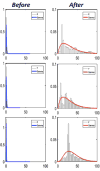Wearable Biosensors to Evaluate Recurrent Opioid Toxicity After Naloxone Administration: A Hilbert Transform Approach
- PMID: 29375277
- PMCID: PMC5782803
Wearable Biosensors to Evaluate Recurrent Opioid Toxicity After Naloxone Administration: A Hilbert Transform Approach
Abstract
Opioid abuse is a rapidly escalating problem in the United States. Effective opioid reversal is achieved with the antidote naloxone, but often does not last as long as the offending opioid, necessitating in-hospital observation. Continuous physiologic monitoring using wearable biosensors represents a potential option to extend monitoring capability outside the clinical setting across the spectrum of opioid abuse including post- naloxone administration. The present study aims to identify the physiologic change that marks the cessation of naloxone's effect. Eleven participants were recruited in the Emergency Department after naloxone administration for an opioid overdose and continuously monitored using a wearable biosensor measuring heart rate, temperature, electrodermal activity and accelerometry. Hilbert transform was used to evaluate a 90- minute post naloxone time point. Physiologic changes were consistent with the onset of opioid drug effect across parameters, but only changes in heart rate and skin temperature research statistical significance.
Figures






References
-
- Rudd RA, Seth P, David F, Scholl L. Increases in Drug and Opioid-Involved Overdose Deaths – United States, 2010-2015. MMWR Morb Mortal Wkly Rep. 2016 Dec;65(5051):1445–1452. - PubMed
-
- Nelson LS, Howland MA. Goldfrank’s Toxicologic Emergencies. New York: McGraw Hill; 2015. pp. 510–515.
-
- Watson WA, Steele MT, Muelleman RL. Opioid toxicity recurrence after an initial response to naloxone. Clinical …. 1998 - PubMed
Grants and funding
LinkOut - more resources
Full Text Sources
